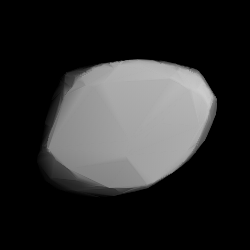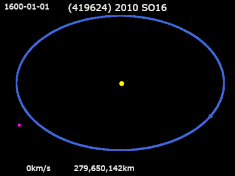
3753 Cruithne is a Q-type, Aten asteroid in orbit around the Sun in 1:1 orbital resonance with Earth, making it a co-orbital object. It is an asteroid that, relative to Earth, orbits the Sun in a bean-shaped orbit that effectively describes a horseshoe, and that can change into a quasi-satellite orbit. Cruithne does not orbit Earth and at times it is on the other side of the Sun, placing Cruithne well outside of Earth's Hill sphere. Its orbit takes it near the orbit of Mercury and outside the orbit of Mars. Cruithne orbits the Sun in about one Earth year, but it takes 770 years for the series to complete a horseshoe-shaped movement around Earth.

4183 Cuno, provisional designation 1959 LM, is an eccentric, rare-type asteroid, classified as near-Earth object and potentially hazardous asteroid of the Apollo group, and measures approximately 4 kilometers in diameter.

1743 Schmidt, provisional designation 4109 P-L, is a dark background asteroid from the inner regions of the asteroid belt, approximately 19 kilometers in diameter. It was discovered during the Palomar–Leiden survey on 24 September 1960, by astronomers Ingrid and Cornelis van Houten at Leiden, on photographic plates taken by Tom Gehrels at Palomar Observatory in California. The C-type asteroid has a rotation period of 17.5 hours. It was named for the optician Bernhard Schmidt.
1179 Mally, provisional designation 1931 FD, is an asteroid and long-lost minor planet from the central region of the asteroid belt, approximately 13 kilometers in diameter. Discovered by Max Wolf in 1931, the asteroid was lost until its rediscovery in 1986. The discoverer named it after his daughter-in-law, Mally Wolf.
5653 Camarillo ( KAM-ə-REE-oh), provisional designation 1992 WD5, is a stony asteroid and near-Earth object of the Amor group, approximately 1.5 kilometers in diameter.

1917 Cuyo is an stony asteroid and near-Earth object of the Amor group, approximately 5.7 kilometers in diameter. It was discovered on 1 January 1968, by astronomer Carlos Cesco and A. G. Samuel at El Leoncito Observatory, Argentina.
1372 Haremari, provisional designation 1935 QK, is a rare-type Watsonian asteroid and a suspected trojan of Ceres from the central regions of the asteroid belt, approximately 26 kilometers in diameter. It was discovered on 31 August 1935, by astronomer Karl Reinmuth at the Heidelberg-Königstuhl State Observatory in southwest Germany. The asteroid was named for all female staff members of the Astronomical Calculation Institute.
2882 Tedesco, provisional designation 1981 OG, is a Themistian asteroid from the outer regions of the asteroid belt, approximately 22 kilometers in diameter. It was discovered on 26 July 1981, by astronomer Edward Bowell at the Anderson Mesa Station near Flagstaff, Arizona. The likely elongated C-type asteroid has a rotation period of 19.8 hours. It was named for American astronomer Ed Tedesco.
1323 Tugela, provisional designation 1934 LD, is a dark background asteroid from the outer regions of the asteroid belt, approximately 60 kilometers in diameter. It was discovered on 19 May 1934, by South African astronomer Cyril Jackson at the Union Observatory in Johannesburg. The asteroid was named for the Tugela River in western South Africa.
2004 TG10, is an eccentric asteroid, classified as near-Earth object and potentially hazardous asteroid of the Apollo group. First observed by the Spacewatch survey on 8 October 2004, it may be a fragment of Comet Encke and is the source of the Northern Taurids meteor shower seen annually in November and the June Beta Taurids. The asteroid may be larger than one kilometer in diameter.
(5645) 1990 SP is an eccentric and tumbling asteroid, classified as near-Earth object of the Apollo group, approximately 1.7 kilometers in diameter. It was discovered on 20 September 1990, by Scottish–Australian astronomer Robert McNaught at the Siding Spring Observatory in Canberra, Australia. Scientists have said that it has a '1 in 364 billion chance' of colliding with the Earth.
(5646) 1990 TR is a probable rare-type binary asteroid classified as near-Earth object of the Amor group, approximately 2.3 kilometers in diameter. It was discovered on 11 October 1990, by Japanese astronomers Seiji Ueda and Hiroshi Kaneda at Kushiro Observatory near Kushiro, in eastern Hokkaido, Japan.
(242450) 2004 QY2 (prov. designation:2004 QY2) is an asteroid on an eccentric orbit, classified as near-Earth object and potentially hazardous asteroid of the Apollo group, approximately 3 kilometers (2 miles) in diameter. It was discovered on 20 August 2004 by the Siding Spring Survey at an apparent magnitude of 16.5 using the 0.5-metre (20 in) Uppsala Southern Schmidt Telescope. It is one of the largest potentially hazardous asteroids known to exist.
2013 BS45 (also written 2013 BS45) is a horseshoe companion to the Earth like 3753 Cruithne. Like Cruithne, it does not orbit the Earth in the normal sense and at times it is on the other side of the Sun, yet it still periodically comes nearer to the Earth in sort of halo orbit before again drifting away. While not a traditional natural satellite, it does not quite have normal heliocentric orbit either and these are sometimes called quasi-satellites or horseshoe orbits.
(386454) 2008 XM is a highly eccentric, sub-kilometer-sized asteroid, with one of the smallest known perihelions among all minor planets. It is classified as near-Earth object of the Apollo group and was discovered on 2 December 2008, by the LINEAR program at Lincoln Laboratory's Experimental Test Site in Socorro, New Mexico, United States.
2001 GO2 is a very small asteroid and near-Earth object of the Apollo group, approximately 50 meters (160 feet) in diameter. Like 2003 YN107, it is in a co-orbital configuration relative to Earth moving in a 1:1 mean-motion resonance. It was first observed on 13 April 2001, by astronomers with the LINEAR program at the Lincoln Lab's ETS near Socorro, New Mexico, in the United States. 2001 GO2 has not been observed since its short four-day observation period in April 2001.
2015 XX169 (also written 2015 XX169) is an Apollo asteroid that is a temporary horseshoe companion to the Earth, the tenth known Earth horseshoe librator. A close encounter with the Earth on 14 December 2015 caused the value of the semi-major axis of 2015 XX169 to drift slowly upwards, and the object evolved from an Aten asteroid to an Apollo asteroid about a year after this close approach.
2015 YQ1 (also written 2015 YQ1) is an Apollo asteroid that is a temporary horseshoe companion to the Earth, the twelfth known Earth horseshoe librator. It experienced a close encounter with the Earth on 2015 December 22 at 0.0037 AU.
2015 YA is a sub-kilometer asteroid, classified as near-Earth object of the Aten group, that is a temporary horseshoe companion to the Earth. It is the 11th known Earth horseshoe librator. Prior to a close encounter with the Earth on 15 December 2015, 2015 YA was an Apollo asteroid.
(163243) 2002 FB3, provisional designation 2002 FB3, is a stony asteroid on an eccentric orbit, classified as near-Earth object and potentially hazardous asteroid of the Athen group, approximately 1.6 kilometers (1 mile) in diameter. It was discovered on 18 March 2002, by astronomers with the Lincoln Near-Earth Asteroid Research at the Lincoln Laboratory's Experimental Test Site near Socorro, New Mexico, in the United States. The Q-type asteroid has a rotation period of 6.2 hours.









